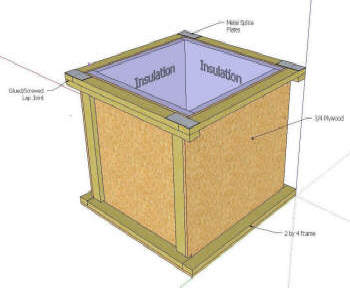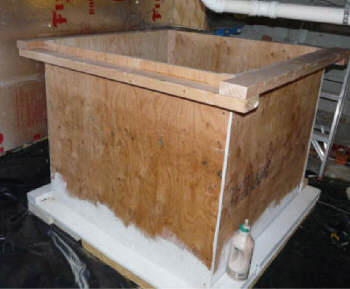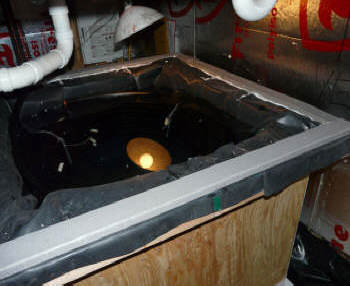This is my third system using this type of tank, and I have become a firm
believer in the design -- which goes back to at least the 70's.
It can provide large capacity
inexpensively. The larger capacity, well insulated tank improves system performance.
EPDM lined tanks have proven to
have a long life, and at the end of the liner life (15 years?), the EPDM
liner can be replaced at a cost of about $50, and you are good to go for
another 15 years.
The EPDM liner can handle
temperatures up to 180F+, although life is reported to be longer if the tank
is kept to 170F or below -- it should be really long at the 160F or less
that this system normally operates at.
The tank can be made to fit in,
and make efficient use of limited spaces (in my case a limited height crawl
space).
AND, it can be built in pieces that fit into areas with limited access (such
as my crawl space).
The tank is unpressurized and
vented to atmosphere -- it can (and does) serve as both the hot water
storage tank and the drainback tank for the collector. This combined
functionality eliminates one more expensive item from the system.
The design allows you to use as
much insulation as you like to reduce heat loss.
The tank is large enough to allow
the use of a large coil of plastic pipe as the heat exchanger. This
makes for an inexpensive and essentially 100% efficient
heat exchanger.
The lack of any liner
penetrations below the waterline eliminates the possibility of leaks at
penetration points.
On the negative side, you need to
be certain that the tank sits on level smooth ground, and that it does not
sit in a puddle.
Its not as nice to look at as a
cool new stainless steel tank -- but, you could always have the kids draw
some artwork on it -- the couple thousand dollars you save will by a lot of
crayons.
If you decide the EPDM lined box
tank described here is not for you, here are a few other alternatives:
- There is a scheme that uses
multiple plastic barrels that is described on the
JC-Solarhomes website. One caution with this design is that
maximum tank temperature is limited by the plastic material -- you will need
a way to keep the system from heating the barrels over this limit.
- Some have used precast septic
tanks for outdoor locations. They must, of course, be well insulated.
- Our friend Tom at
American Solartechnics makes several solar heated water storage tanks
including a new kit version that is very reasonable in price.
- There are places that will make
custom liners for any tank size you specify. These liners will fit
your tank without the folding needed for our single sheet EPDM liner.
- And there is this
"hole in the ground" tank -- the ultimate in simplicity!
- There are a few more ideas for
tanks on our
tank page...



